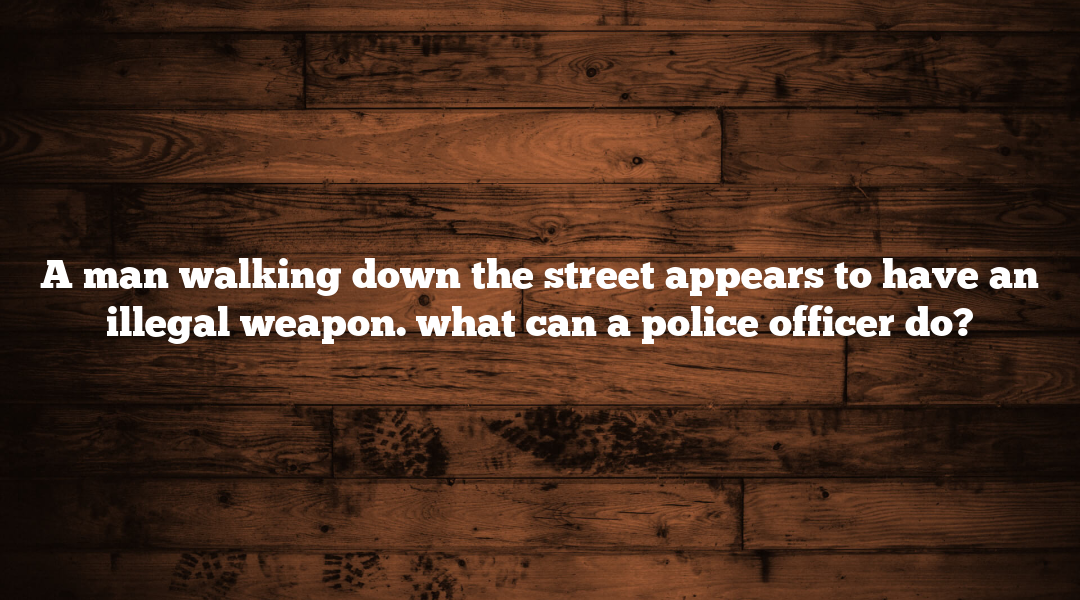A man walking down the street appears to have an illegal weapon. what can a police officer do?
In the complex landscape of urban policing, one of the most pressing challenges officers face is the management of suspected illegal weapons during street patrols. This scenario presents a unique set of difficulties, balancing the enforcement of the law with the preservation of public trust and individual rights.
The Dual Role of Law Enforcement
Officers on patrol bear the responsibility of ensuring public safety while also respecting the legal rights of citizens. This dual role becomes particularly challenging when there are suspicions of illegal weapon possession, as the situation demands swift and judicious action.
Understanding the Legal Framework
Constitutional Rights and Policing Conclusion
The foundation of policing suspected illegal weapons starts with a thorough understanding of constitutional rights. Officers must navigate the delicate balance between the Fourth Amendment, which protects citizens from unreasonable searches and seizures, and the public safety imperative to address potential threats.
The Dynamics of Reasonable Suspicion
Reasonable suspicion plays a crucial role in law enforcement’s approach to suspected illegal weapons. Officers are trained to identify and articulate specific, observable behaviors or circumstances that warrant further investigation within the bounds of the law.
Tactical Approaches on the Street
Initial Assessment and Observation
Effective policing begins with careful observation. Officers are trained to identify potential signs of illegal weapon possession, such as unusual bulges in clothing or individuals exhibiting nervous or evasive behavior.
Strategic Engagement with Suspects
Once a potential threat is identified, officers must approach the situation strategically. This involves measured steps in engaging the suspect, employing techniques that prioritize safety while seeking to de-escalate potential tension.
De-escalation Strategies
Importance of De-escalation
De-escalation is a critical skill in these encounters. Officers use a combination of communication techniques, body language, and tactical positioning to reduce the likelihood of a violent confrontation.
Training and Preparedness
Continuous training in de-escalation and crisis intervention is essential for law enforcement. This training equips officers with the tools and confidence needed to handle high-stress situations effectively.
The Decision to Use Force
Assessing the Level of Threat
The decision to use force is a significant one, guided by the principle of proportionality. Officers must assess the level of threat and respond with a level of force appropriate to the situation, always considering the safety of all involved.
Documentation and Accountability
In instances where force is used, rigorous documentation and review processes are in place. These procedures ensure transparency and accountability, providing a record for both internal review and public scrutiny.
Community Engagement and Building Trust
The Role of Community Policing
Fostering a positive relationship with the community is a key aspect of modern policing. Community engagement initiatives provide an avenue for dialogue, education, and collaboration, building a foundation of mutual respect and understanding.
Transparency in Operations
Transparency in police operations is crucial for maintaining public trust. Open communication about policies, procedures, and the rationale behind officers’ actions strengthens the bond between law enforcement and the community.
Conclusion
Addressing suspected illegal weapons during street patrols is a multifaceted challenge that law enforcement officers face daily. It requires a blend of legal knowledge, tactical skill, communication proficiency, and an unwavering commitment to public service. By focusing on these key areas, officers can effectively navigate these complex situations, ensuring public safety while upholding the principles of justice and individual rights.
This structured outline and beginning provide a solid foundation for your article. You can expand on each section by including real-life examples, statistical data, further explanations of legal principles, and insights from law enforcement experts to reach the desired word count.






